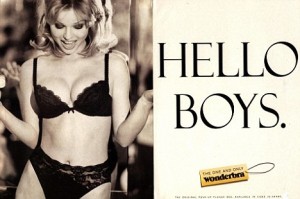According to Angela McRobbie, post-modern feminism is affiliated with a rise in consumerism associated with identify, gender and sexuality. McRobbie contends that we have moved away from identity politics, being those controlled by the government, to a much more capitalist corporation which is marked by consumerism. This pressure to conform, comply and consume in order to belong in society has become inherent to the point of internalisation. Additionally, this sense of belonging is embedded deep within our identities. It has become such a naturalised act that we don’t even realise the ways in which we participate. Gender is a good example of how we repeatedly reproduce a factor of our identity in a naturalised way. This is particularly evident in how sexuality has become a technology of representation of gender.
After watching the ‘Pink Ribbons’ documentary on breast cancer I couldn’t help but think back to an interview I’d watched last year titled ‘The breasts don’t make the woman.’ I’ve posted the link to the interview below and also the link to the StyleLikeU website where you can find more interviews of similar nature.
http://stylelikeu.com/
The aim of this interview, and of others conducted by StyleLikeU, is to diminish universal concepts of beauty and expectations of women and men. I find Gail’s story to be very admirable in how she challenged notions of womanhood and feminine beauty. Instead of focusing on the loss of her breasts as an insecurity, Gail moves forward and embraces her new body as “a road map of everything [she’s] lived through.” At one point in the interview, when describing the size of her breasts as a young woman, she tells: ‘I am feminine. I don’t need to wear a padded bra to show that.’ This particular line made me think of the discussion we were having in class this week after examining advertisements by the Wonderbra and Victoria Secret.

Gossard Wonderbra 1994 1990s UK Eva Herzigova erotica womens underwear models supermodels Hello Boys
Despite Wonderbra’s aim to depict women owning their sexuality and thus feeling liberated to the degree of objectifying themselves, the purpose of the advertisement is still to sell a bra. And a bra with the specific function to accentuate and ‘push up’ a woman’s breasts. It’s true that it is difficult to see the model as a victim due to the fact that she plays with the consumer and flaunts the knowledge that she is in control of embodying and engaging her own sexuality. However, it is too soon to declare that these types of advertisements suggest that women have reached a new era of liberation. The advertisement only touches on one type of woman: the white, thin, wealthy woman. And as aforementioned, the advertisement is still selling a product which alienates and does not resonate with numerous women or those who identify as women, such as Gail Chovan. Instead, advertisements like the Wonderbra and Victoria Secret present a homogenisation of bodies and image in a sexualised way.
In referring back to McRobbie, it is of course the systems defined by capitalism that we should be critical of in producing the harmful objectification of bodies in order to increase consumerism.
-Aimee